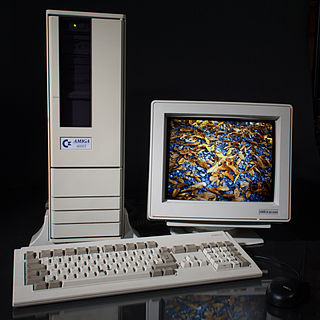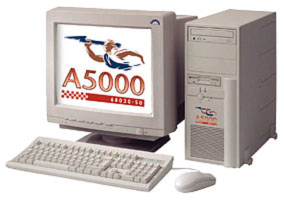
Amiga is a family of personal computers produced by Commodore from 1985 until the company's bankruptcy in 1994, with production by others afterward. The original model is one of a number of mid-1980s computers with 16-bit or 16/32-bit processors, 256 KB or more of RAM, mouse-based GUIs, and significantly improved graphics and audio compared to previous 8-bit systems. These include the Atari ST—released earlier the same year—as well as the Macintosh and Acorn Archimedes. The Amiga differs from its contemporaries through custom hardware to accelerate graphics and sound, including sprites, a blitter, and four channels of sample-based audio. It runs a pre-emptive multitasking operating system called AmigaOS.

The Amiga 500, also known as the A500, was the first popular version of the Amiga home computer, "redefining the home computer market and making so-called luxury features such as multitasking and colour a standard long before Microsoft or Apple sold these to the masses." It contains the same Motorola 68000 as the Amiga 1000, as well as the same graphics and sound coprocessors, but is in a smaller case similar to that of the Commodore 128.

The Amiga 1000, also known as the A1000, is the first personal computer released by Commodore International in the Amiga line. It combines the 16/32-bit Motorola 68000 CPU which was powerful by 1985 standards with one of the most advanced graphics and sound systems in its class. It runs a preemptive multitasking operating system that fits into 256 KB of read-only memory and was shipped with 256 KB of RAM. The primary memory can be expanded internally with a manufacturer-supplied 256 KB module for a total of 512 KB of RAM. Using the external slot the primary memory can be expanded up to 8.5 MB.

The Amiga 600, also known as the A600, and full title Commodore Amiga 600, is a home computer introduced in March 1992. It is the final Amiga model based on the Motorola 68000 and the 1990 Amiga Enhanced Chip Set. A redesign of the Amiga 500 Plus, it adds the option of an internal hard disk drive and a PCMCIA port. Lacking a numeric keypad, the A600 is only slightly larger than an IBM PC keyboard, weighing approximately 6 pounds (2.72kg). It shipped with AmigaOS 2.0, which was considered more user-friendly than earlier versions of the operating system.

In computing, an expansion card is a printed circuit board that can be inserted into an electrical connector, or expansion slot on a computer's motherboard to add functionality to a computer system. Sometimes the design of the computer's case and motherboard involves placing most of these slots onto a separate, removable card. Typically such cards are referred to as a riser card in part because they project upward from the board and allow expansion cards to be placed above and parallel to the motherboard.

The Amiga 3000, or A3000, is a personal computer released by Commodore in June 1990. It is the successor to the Amiga 2000 and its upgraded model Amiga 2500 with more processing speed, improved graphics, and a new revision of the operating system.

The Amiga 2000 (A2000) is a personal computer released by Commodore in March 1987. It was introduced as a "big box" expandable variant of the Amiga 1000 but quickly redesigned to share most of its electronic components with the contemporary Amiga 500 for cost reduction. Expansion capabilities include two 3.5" drive bays and one 5.25" bay that could be used by a 5.25" floppy drive, a hard drive, or CD-ROM once they became available.
Chip RAM is a commonly used term for the integrated RAM used in Commodore's line of Amiga computers. Chip RAM is shared between the central processing unit (CPU) and the Amiga's dedicated chipset. It was also, rather misleadingly, known as "graphics RAM".

The Amiga 4000, or A4000, from Commodore is the successor of the Amiga 2000 and Amiga 3000 computers. There are two models: the A4000/040 released in October 1992 with a Motorola 68040 CPU, and the A4000/030 released in April 1993 with a Motorola 68EC030.

The X68000 is a home computer created by Sharp Corporation. It was first released in 1987 and sold only in Japan.

The FM Towns is a Japanese personal computer built by Fujitsu from 1989 to 1997. It started as a proprietary PC variant intended for multimedia applications and PC games, but later became more compatible with IBM PC compatibles. In 1993, the FM Towns Marty was released; it is a game console compatible with existing FM Towns games.

The Macintosh Classic II is a personal computer designed and manufactured by Apple Computer, Inc. from October 1991 to September 1993. The system has a compact, appliance design with an integrated 9" monitor, typical of the earliest of the Macintosh range. A carrying handle moulded into the case added a degree of portability at a time when laptops were still relatively uncommon.
Released as the expansion bus of the Commodore Amiga 3000 in 1990, the Zorro III computer bus was used to attach peripheral devices to an Amiga motherboard. Designed by Commodore International lead engineer Dave Haynie, the 32-bit Zorro III replaced the 16-bit Zorro II bus used in the Amiga 2000. As with the Zorro II bus, Zorro III allowed for true Plug and Play autodetection wherein devices were dynamically allocated the resources they needed on boot.
The Apple Network Server (ANS) was a line of PowerPC-based server computers designed, manufactured and sold by Apple Computer, Inc. from February 1996 to April 1997. It was codenamed "Shiner" and originally consisted of two models, the Network Server 500/132 and the Network Server 700/150, which got a companion model, the Network Server 700/200 with a faster CPU in November 1996.

Minimig is an open source re-implementation of an Amiga 500 using a field-programmable gate array (FPGA).

The Amiga 4000T, also known as A4000T, is a tower version of Commodore's A4000 personal computer. Using the AGA chipset, it was originally released in small quantities in 1994 with a 25 MHz Motorola 68040 CPU, and re-released in greater numbers by Escom in 1995, after Commodore's demise, along with a new variant which featured a 50 MHz Motorola 68060 CPU. Despite the subsequent demise of Escom, production was continued by QuikPak in North America into at least 1998.

The Amiga 1200, or A1200, is a personal computer in the Amiga computer family released by Commodore International, aimed at the home computer market. It was launched on October 21, 1992, at a base price of £399 in the United Kingdom and $599 in the United States.

The Power A5000 was a planned Amiga clone computer, announced by German DCE Computer Service GmbH and British Amiga peripherals manufacturer Power Computing Ltd.. It was one of the first Amiga clone computers announced after Gateway purchased the Amiga in 1997.
In addition to the Amiga chipsets, various specially designed chips have been used in Commodore Amiga computers that do not belong to the 'Amiga chipset' in a tight sense.















